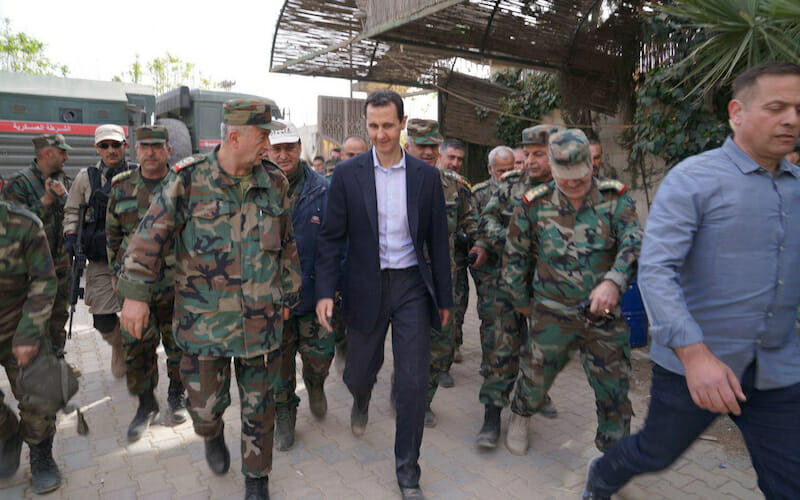
The Need for a New Diplomatic Approach in Syria
Over the last seven years of the Syrian Civil War, perhaps the one thing all sides in the conflict can at least nominally agree upon is the need for a diplomatic and political agreement. Figures as different as John Kerry, Vladimir Putin, Supreme Ayatollah Ali Khamanei, Tayyip Erdogan, and Donald Trump have all stated their unequivocal belief in the need for a political solution for Syria. Yet it is unlikely that a political solution will be produced by diplomatic talks where the various rebel factions have equal credibility at the negotiation table as the Assad regime. Rather, the U.S. needs to adopt a diplomatic position that assumes that Syrian President Bashar al-Assad ultimately wins the war.
The Assad regime has re-conquered most territory west of the Euphrates River, with the east mostly in the hands of Syrian Kurds. Just two years ago, the regime tethered on collapse. Then, aided by Russian planes and Iranian-funded Shia militias, regime forces made a remarkable comeback. In a campaign defined by brutality and uncompromising terror, the Syrian Arab Army and its allies retook Aleppo, the last major urban center for Syrian rebels. Damascus has regained border crossing with Iraq for the first time in years, and both regime and Kurdish forces, helped by their respective patrons, have withered IS to almost nothing. With the majority of the Syria’s population back in regime hands, it stands to reason that a military victory, far from being unlikely, is a matter of time.
Maps of Syria charting territorial shifts over the course of the war tell a remarkable tale. In June 2015 for example, four years into the war, the Syrian regime had lost half of its territory just to the Islamic State. Al-Assad’s government was restricted mainly to Syria’s western regions and along the Mediterranean coast, with pockets of isolated strongholds surrounded by Islamic State and Kurdish forces. The notion at that time of al-Assad forcing military terms on his multiple opponents was laughable. The situation deteriorated even further, and by March 2017 the Syrian regime controlled only ~21% of Syria’s 185,180 km2. Damascus was barely ahead of the total land under various opposition factions, and far behind the 80,380 km2 controlled by the Islamic State. Yet within one year, the regime made an incredible comeback. By February 2018, 102,290 km2 and 70.8% of the Syrian population lay under the jurisdiction of forces loyal or allied to al-Assad. Since then, the regime has greatly outpaced its wartime rivals in land and human resources. While we can stipulate as to why and how (perhaps thanks to its devoted allies in Moscow and Tehran) Damascus has been able to shift the tide, it would be difficult to dismiss the regime’s successes.
For now, the war continues. Turkey, an active player in the war since 2015, is fighting the Kurds in Afrin in northwestern Syria. Syrian opposition factions, while beaten, are still alive in pockets of Idlib. The question, however, is for how long. The regime may never be able to force terms on the Kurds east of the Euphrates, especially as the Kurds can rely on American support in the east. However, if Damascus, with continued help from its backers in Moscow and Tehran, can succeed in clearing out the remaining areas of Syrian rebels and hold onto the major urban centers of western Syria, then it may reach a position where it can plausibly declare victory.
In fact, the regime and its allies are already in the process of celebrating their soon-to-be victory. While this may not be the first time Putin has declared mission accomplished, we can assume where directions are headed when al-Assad flies out to Russia for victory speeches.
Given that Assad stands on the brink of victory, a political condition is unlikely. Syrian troops have begun encroaching upon the last rebel-held suburb of Damascus. The U.S., Turkey, and France have not signaled any interest in tackling the regime. Russia and Iran remain steadfast to aiding Damascus. Rather than for the U.S., Russia, or other major powers to try to bring Assad and other rebel factions together to forge a political agreement, greater effort should be put into extracting guarantees from Damascus. When the civil war does finally end at some point, the international community must assure the safety of civilians and former rebels from potentially vengeful pro-Assad forces. Additionally, the U.S. and European nations must advocate for the safe return of Syrian refugees, but under agreed upon conditions with the Assad regime that warrants their security.
If the international community continues the façade that the civil war will be resolved by a peace agreement signed by both Damascus and rebel factions, the Assad regime will end the war fully on its terms. A return to strict authoritarian rule in which Syrian citizens remain vulnerable to the dictates of the Assad regime will likely occur. However, if the U.S. and other invested members of the international community begin serious discussions with Assad and his main backers on the future of Syria, the international community may at least then be able to prevent many of the socio-political grievances that ignited the Syrian Civil War to reemerge. In return for Assad’s cooperation, the U.S. and other powers involved in Syria could slowly begin disengaging in military operations in Syria’s airspace and on Syrian territory. If Damascus proves willing to allow Syrian refugees abroad to return home and under the monitoring of international observers to confirm their well-being, Washington could even go as far as to end support for rebel factions.
Accepting Assad, a war criminal who gassed his own people, will not be politically easy to do. Nevertheless, direct diplomacy with Assad must be done if the safety of millions of Syrians both under Assad’s control and abroad are at stake. The U.S. and its allies need to face and act upon the reality of the war at hand, and not the conditions of the war they would prefer.

